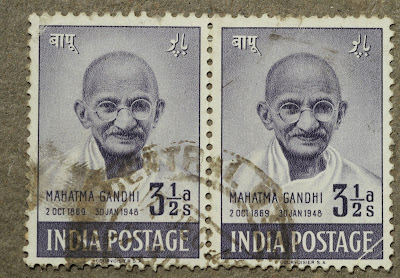1950 is a landmark year for India. This is the year, when India adopted its constitution and what a constitution it has been. It has been very successful in keeping a diverse nation united and managed to prove all pessimistic pundits wrong. In commemoration of the coming in-force of the constitution, 4 stamps were released. These were the only commemorative stamps that were released that year.
A 2 anna, scarlet coloured stamp depicting rejoicing crowds. Two children are seen viewing a procession of cavaliers carrying flags and blowing trumpets which herald India’s attainment of full Nationhood.
A 3.5 anna Ultramarine stamp depicting Quill, Ink-well and verse. The background shows Mahatma Gandhiji’s favourite hymn “Raghupati Raghav Raja Ram.”, symbolize Nation’s Education.
A 4 anna Violet stamp with a ear of corn and a plough
The 4th stamp was a maroon 12 anna Spinning-wheel and cloth.
The stamps were designed by the British ad agency D.J. Keymer & Co. This is the same company that Satyajit Ray first worked for. Coincidentally, it was this year (1950), that Ray was sent to England by the company, where watching about a 100 movies in six months Ray got motivated to be a film-maker.
A 2 anna, scarlet coloured stamp depicting rejoicing crowds. Two children are seen viewing a procession of cavaliers carrying flags and blowing trumpets which herald India’s attainment of full Nationhood.
A 3.5 anna Ultramarine stamp depicting Quill, Ink-well and verse. The background shows Mahatma Gandhiji’s favourite hymn “Raghupati Raghav Raja Ram.”, symbolize Nation’s Education.
A 4 anna Violet stamp with a ear of corn and a plough
The 4th stamp was a maroon 12 anna Spinning-wheel and cloth.
The stamps were designed by the British ad agency D.J. Keymer & Co. This is the same company that Satyajit Ray first worked for. Coincidentally, it was this year (1950), that Ray was sent to England by the company, where watching about a 100 movies in six months Ray got motivated to be a film-maker.















